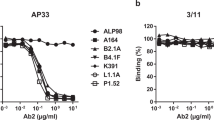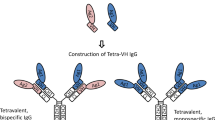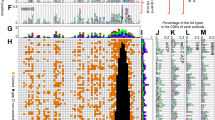Abstract
IDIOTOPES are antigenic determinants, unique to an antibody or group of antibodies, defined by the reaction of anti-idiotopic antibodies with the antibodies bearing the idiotopes. The ensemble of idiotopes of an antibody constitutes its idiotype. Idiotypes are useful as markers to follow specific antibodies and clones of cells in immune responses and the inheritance of immunoglobulin genes. As external antigens and anti-idiotypic antibodies can competitively bind the combining site of specific antibodies, some anti-idiotypic antibodies may resemble the external antigen, thus mimicking its structure. It has been proposed1–5 that an anti-idiotypic antibody, anti-anti-X, may resemble the external antigen X and thus carry its 'internal image', but this idea is not unequivocally supported by the three-dimensional structures of anti-idiotopic antibodies6–9, either because the structures of the external antigen8 or of the anti-idiotopic antibody7 were unknown, or because the anti-idiotopic antibodies showed no resemblance to the external antigens6,9 (reviewed in ref. 10). Functional mimicry of ligands of biological receptors by anti-idiotypic antibodies has been described in several systems (reviewed in ref. 11). But how closely can antibodies mimic antigens at the molecular level? Here we present the crystal structure of an idiotope-anti-idiotope complex between the Fv fragments of the anti-lysozyme antibody D1.3 and the anti-D1.3 antibody E5.2. D1.3 contacts the antigen, lysozyme and the anti-idiotopic E5.2 through essentially the same combining-site residues. In addition, E5.2 interacts with D1.3, making contacts similar to those between lysozyme and D1.3. Thus, the anti-idiotopic antibody E5.2 mimics lysozyme in its binding interactions with D1.3. Validating these observations, E5.2, used as an immu-nogen, induces an anti-lysozyme response.
This is a preview of subscription content, access via your institution
Access options
Subscribe to this journal
Receive 51 print issues and online access
$199.00 per year
only $3.90 per issue
Buy this article
- Purchase on Springer Link
- Instant access to full article PDF
Prices may be subject to local taxes which are calculated during checkout
Similar content being viewed by others
References
1. Jerne, N. K. Ann. Immun. Inst. Pasteur 125C, 373-389 (1974). 2. Nisonoff, A. & Lamoyi, E. Clin. Immun. Immunopath. 21, 397-406 (1981). 3. Roitt, I. M. et a/. Lancet 1, 1041-1045 (1981). 4. Sacks, D. L, Kelsoe, G. H. & Sachs, D. H. Springer Semin. Immunopath. 6, 79-97 (1983). 5. Leu, J-G., Chen, B-X., Diamanduros, A. W. & Erlanger, B. F. Proc. natn. Acad. Sci. U.S.A. 91, 10690-10694 (1994). 6. Bentley, G. A., Boulot, G., Riottot, M-M. & Poljak, R. J. Nature 348, 254-257 (1990). 7. Garcia, K. C., Ronco, P. M., Verroust, P. J., Brunger, A. T. & Amzel, L M. Science 257, 502-507 (1992). 8. Ban, N. et a/. Proc. natn. Acad. Sci. U.S.A. 91, 1604-1608 (1994). 9. Evans, S. V., Rose, D. R., To, R., Young, N. M. & Bundle, D. R. J. molec. Biol. 241, 691-705 (1994). 10. Poljak, R. J. Proc. natn. dead. Sci. U.SA. 91, 1599-1600 (1994). 11. Gaulton, G. N. & Greene, M. I. A. Rev. Immun. 4, 253-280 (1986). 12. Kabat, E. A., Wu, T. T., Perry, H. M., Gottesman, K. S. & Foeller, C. Sequences of Proteins of Immunological Interest 5th edn (NIH Publication No. 91-3242, US Department of Health and Human Services, Bethesda, MD, 1991). 13. Tello, D. et a/. J. molec. Recogn 7, 57-62 (1994). 14. Bhat, T. N. et a/. Proc. natn. Acad. Sci. U.SA. 91, 1089-1093 (1994). 15. Goldbaum, F. A. et a/. J. molec. Biol. 241, 739-743 (1994). 16. Navaza, J. Acta crystallogr. A50, 157-163 (1994). 17. Boulot, G. et a/. J. molec. Biol. 213, 617-619 (1990). 18. Brunger, A. T. X-PLOR Version 3.1. A System for X-ray Crystallography and NMR (Yale Univ. Press, New Haven and London, 1992). 19. Amit, A. G., Mariuzza, R. A., Phillips, S. E. V. & Poljak, R. J. Science 233, 747-753 (1986). 20. Boulot, G. et a/. J. molec. Biol. 194, 577-579 (1987). 21. Harper, M., Lema, F., Boulot, G. & Poljak, R. J. Molec. Immun. 2, 97-108 (1987).
Author information
Authors and Affiliations
Rights and permissions
About this article
Cite this article
Fields, B., Goldbaum, F., Ysern, X. et al. Molecular basis of antigen mimicry by an anti-idiotope. Nature 374, 739–742 (1995). https://doi.org/10.1038/374739a0
Received:
Accepted:
Issue Date:
DOI: https://doi.org/10.1038/374739a0
This article is cited by
-
Development of a structural epitope mimic: an idiotypic approach to HCV vaccine design
npj Vaccines (2021)
-
Molecular Mechanism and Energy Basis of Conformational Diversity of Antibody SPE7 Revealed by Molecular Dynamics Simulation and Principal Component Analysis
Scientific Reports (2016)
-
Anti-idiotypic nanobody as citrinin mimotope from a naive alpaca heavy chain single domain antibody library
Analytical and Bioanalytical Chemistry (2015)
-
Imperfect interfaces
Nature Structural Biology (1998)
-
Idiotypic immunization induces immunity to mutated p53 and tumor rejection
Nature Medicine (1998)
Comments
By submitting a comment you agree to abide by our Terms and Community Guidelines. If you find something abusive or that does not comply with our terms or guidelines please flag it as inappropriate.



